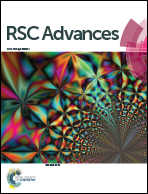Reverse atom transfer radical polymerization of dimethyl itaconate initiated by a new azo initiator: AIBME†
Abstract
Reverse atom transfer radical polymerization (RATRP) was used to synthesize poly(dimethyl itaconate) (PDMI) using an AIBME/CuBr2/dNbpy system. The number average molecular weight (Mn) of PDMI was as high as Mn = 15 000 g mol−1, the monomer conversion rate reached up to 70%, and the dispersity remained low (Đ = 1.06–1.38). The first-order kinetics of PDMI are discussed in detail. The AIBME initiator had a higher initiation efficiency than the AIBN initiator. As the ratio of initiator (AIBME) to catalyst (CuBr2) decreased, the Mn and Đ of PDMI decreased. At 60 °C and 80 °C, the Mn of PDMI was much higher than the theoretical number average (Mn,th), and the Đ of PDMI broadened with the conversion rate. At 100 °C, the Đ of PDMI remained low, and the Mn of PDMI was closer to the Mn,th. As the ratio of monomer (DMI) to initiator (AIBME) increased, the Mn of PDMI changed little over time. These phenomena could be explained by the influence of the initiator and catalyst on polymerization kinetics.



 Please wait while we load your content...
Please wait while we load your content...